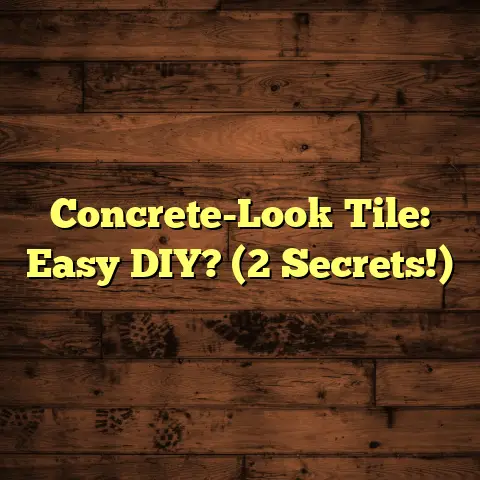Hardwood: Polyurethane Coats? (2 Is The Max!)
Many of you are probably here because you’re knee-deep in a home renovation, maybe refinishing that beautiful oak floor you uncovered under layers of old linoleum. Or perhaps you’re just looking to protect your investment from the daily wear and tear of life.
Whatever your reason, understanding hardwood finishes, especially polyurethane, is crucial. It’s the key to unlocking a floor that’s not only gorgeous but also durable and long-lasting. I want to share my insights and help you avoid common pitfalls. Trust me, a little knowledge goes a long way in the world of hardwood flooring.
Section 1: Understanding Hardwood Floors
1.1 What is Hardwood Flooring?
Okay, let’s start with the basics. Hardwood flooring comes from, you guessed it, hardwood trees! These are deciduous trees like oak, maple, cherry, walnut, and hickory. Unlike softwood trees (pine, fir), hardwoods generally grow slower and are denser, making them more durable.
- Oak: The most popular choice, known for its durability, grain pattern, and ability to take stains well. Red oak and white oak are the two main types.
- Maple: A lighter-colored wood with a tight grain, offering a modern and clean look. It’s very hard and resistant to dents.
- Cherry: A beautiful reddish-brown wood that darkens with age. It’s softer than oak or maple but adds a touch of elegance.
There are many other species, each with its unique character. The Janka hardness scale measures the resistance of wood to denting. This is a helpful guide when choosing a wood species for your floor.
1.2 Benefits of Hardwood Flooring
Why choose hardwood? Well, where do I even begin?
- Aesthetic Appeal: Nothing beats the natural beauty and warmth of real wood. It adds character and sophistication to any room.
- Durability: When properly maintained, hardwood can last for decades, even centuries.
- Value Addition: Hardwood floors are a major selling point for homes, increasing their market value.
- Healthier Indoor Air Quality: Unlike some carpets, hardwood doesn’t trap dust, pollen, or pet dander.
- Timeless Style: Hardwood never goes out of style. It’s a classic choice that complements any décor.
I’ve seen homes where the original hardwood floors, hidden for years, were brought back to life and became the centerpiece of the entire design.
1.3 Common Issues with Hardwood Floors
Even with its durability, hardwood isn’t immune to problems. Here are some common issues I encounter:
- Scratches: From pets, furniture, or just everyday foot traffic.
- Fading: Exposure to sunlight can cause the wood to lighten or change color over time.
- Water Damage: Spills, leaks, or high humidity can lead to warping, cupping, or staining.
- Dents: Heavy objects or high heels can leave dents in the wood.
- Gaps: Changes in humidity can cause the wood to expand and contract, creating gaps between planks.
These issues can be minimized with proper care and, most importantly, a good protective finish.
1.4 The Importance of Protective Coatings
This is where polyurethane comes in! Think of it as a shield for your hardwood. It protects against all those nasty things I just mentioned – scratches, water damage, UV rays.
A good finish not only prolongs the life of your floor but also enhances its beauty, bringing out the natural grain and color. Without a protective coating, your hardwood is vulnerable and will quickly show signs of wear and tear.
Section 2: The Role of Polyurethane in Hardwood Finishing
2.1 What is Polyurethane?
Polyurethane is a synthetic resin that forms a hard, durable, and protective coating. It’s used in various applications, from furniture to car parts, but it’s especially popular for hardwood floors.
There are two main types:
- Oil-Based Polyurethane: Known for its durability, amber hue, and longer drying time. It provides a rich, warm look.
- Water-Based Polyurethane: Clearer, faster-drying, and lower in VOCs (volatile organic compounds). It offers a more modern, natural look.
2.2 Chemical Properties of Polyurethane
What makes polyurethane so great for floors? It’s all about its chemical structure. It’s a polymer, meaning it’s made up of long chains of molecules that are tightly linked together.
This creates a dense, flexible film that’s resistant to abrasion, chemicals, and moisture. The molecules also cross-link during the curing process, further strengthening the coating.
2.3 How Polyurethane Works as a Protective Layer
Polyurethane acts as a barrier between your hardwood and the outside world.
- Moisture Resistance: It prevents water from penetrating the wood, preventing warping, staining, and rot.
- Scratch Resistance: It forms a hard surface that can withstand scratches and scuffs from everyday use.
- UV Resistance: Some polyurethanes contain UV inhibitors that help protect the wood from fading caused by sunlight.
I’ve seen floors that were heavily damaged before, but a good polyurethane finish made them look brand new.
2.4 Sheens Available in Polyurethane Finishes
The sheen of your polyurethane finish affects the appearance of your floor. Here are the most common options:
- Gloss: Highly reflective, creating a shiny and dramatic look. Shows scratches more easily.
- Semi-Gloss: A good balance between shine and durability. A popular choice for many homes.
- Satin: A softer, more subtle sheen that hides scratches better than gloss.
- Matte: The least reflective sheen, providing a natural and understated look.
The choice of sheen is a personal preference, but consider the level of traffic your floor will receive. Higher traffic areas benefit from lower sheens that hide scratches better.
Section 3: Choosing the Right Polyurethane Coating
3.1 Factors to Consider
Choosing the right polyurethane can feel overwhelming, but here’s what I consider:
- Type of Wood: Some woods, like maple, require a specific type of polyurethane to prevent blotching.
- Location: High-traffic areas (hallways, kitchens) need more durable finishes than low-traffic areas (bedrooms).
- Desired Finish: Do you want a glossy, modern look or a more natural, matte finish?
- VOC Content: If you’re concerned about air quality, choose a low-VOC water-based polyurethane.
- Budget: Oil-based polyurethanes are generally cheaper than water-based, but the overall cost depends on the size of the area.
3.2 Oil-Based vs. Water-Based Polyurethane
Let’s break down the key differences:
| Feature | Oil-Based Polyurethane | Water-Based Polyurethane |
|---|---|---|
| Appearance | Amber hue, enhances warm tones | Clear, maintains natural wood color |
| Drying Time | Longer (6-8 hours per coat) | Shorter (2-4 hours per coat) |
| Durability | Very durable, excellent scratch resistance | Durable, but may require more coats |
| VOC Content | High, strong odor | Low, minimal odor |
| Application | Can be more difficult to apply evenly | Easier to apply, less prone to brush marks |
| Cost | Generally less expensive | Generally more expensive |
I personally prefer water-based for its ease of use and lower VOCs, but oil-based is still a great option for high-traffic areas where maximum durability is needed.
3.3 Proper Preparation and Application Techniques
No matter which polyurethane you choose, proper preparation is key!
- Sanding: Sand the floor smooth, removing any existing finish or imperfections. Start with a coarse grit sandpaper and gradually move to finer grits.
- Cleaning: Thoroughly vacuum and tack cloth the floor to remove all dust and debris.
- Application: Apply thin, even coats of polyurethane using a high-quality brush or roller. Avoid thick coats that can lead to bubbles or streaks.
- Drying Time: Allow each coat to dry completely before applying the next. Follow the manufacturer’s instructions for drying times.
- Light Sanding Between Coats: Lightly sand between coats with fine-grit sandpaper (220-grit or higher) to create a smooth surface for the next coat.
Section 4: Application Process of Polyurethane Coats
4.1 Step-by-Step Guide
Here’s my tried-and-true method for applying polyurethane:
- Prepare the Room: Remove all furniture and cover any areas you don’t want to get polyurethane on.
- Ventilation: Open windows and doors to ensure adequate ventilation. Wear a respirator to protect yourself from fumes.
- Sand the Floor: As I mentioned before, sanding is crucial.
- Clean the Floor: Remove all dust and debris.
- Apply the First Coat: Pour a small amount of polyurethane into a paint tray and use a brush or roller to apply a thin, even coat. Work in the direction of the wood grain.
- Let it Dry: Allow the first coat to dry completely.
- Lightly Sand: Use fine-grit sandpaper to lightly sand the floor.
- Clean Again: Remove any dust from sanding.
- Apply the Second Coat: Apply a second coat of polyurethane using the same technique as the first.
- Let it Dry Completely: Allow the second coat to dry completely before walking on the floor.
4.2 Necessary Tools and Materials
Here’s what you’ll need:
- Sandpaper: Various grits (coarse, medium, fine)
- Sander: Drum sander or orbital sander
- Vacuum: With a hose attachment
- Tack Cloth: For removing dust
- Paint Tray: For holding polyurethane
- Brush or Roller: High-quality brush or roller designed for polyurethane
- Respirator: To protect yourself from fumes
- Safety Glasses: To protect your eyes
- Drop Cloths: To protect surrounding areas
4.3 Why Two Coats?
I always recommend two coats of polyurethane. Why?
- Enhanced Protection: Two coats provide a thicker, more durable barrier against scratches, water damage, and UV rays.
- Improved Appearance: Two coats create a smoother, more even finish.
- Longer Lifespan: Two coats will extend the life of your floor, reducing the need for frequent re-coating.
While some people might be tempted to apply more than two coats, it’s generally not necessary and can actually lead to problems. Too much polyurethane can create a thick, brittle finish that’s prone to cracking.
4.4 Avoiding Common Mistakes
Here are some common mistakes to avoid:
- Skipping Preparation: Proper sanding and cleaning are essential for a good finish.
- Applying Thick Coats: Thick coats can lead to bubbles, streaks, and uneven drying.
- Not Allowing Enough Drying Time: Rushing the drying process can result in a soft, sticky finish.
- Using the Wrong Tools: Use high-quality brushes and rollers designed for polyurethane.
- Poor Ventilation: Adequate ventilation is crucial for safety and proper drying.
Section 5: Maintenance and Care After Coating
5.1 How to Maintain Your Hardwood Floors
Once your polyurethane finish is dry, here’s how to keep your floors looking their best:
- Regular Cleaning: Sweep or vacuum regularly to remove dust and debris.
- Damp Mopping: Use a damp mop with a mild hardwood floor cleaner. Avoid using excessive water, which can damage the finish.
- Avoid Harsh Chemicals: Don’t use abrasive cleaners, bleach, or ammonia, as these can damage the polyurethane finish.
- Use Area Rugs: Place area rugs in high-traffic areas to protect the floor from scratches and wear.
- Use Furniture Pads: Place felt pads under furniture legs to prevent scratches and dents.
5.2 Periodic Re-Coating
Even with proper care, polyurethane finishes will eventually wear down. Here are some signs that it’s time to re-coat:
- Dull Appearance: The floor loses its shine and looks dull.
- Scratches and Scuffs: The finish is covered in scratches and scuffs.
- Water Stains: Water stains are penetrating the finish and reaching the wood.
- Peeling or Cracking: The finish is peeling or cracking in certain areas.
Re-coating involves lightly sanding the existing finish and applying a fresh coat of polyurethane. This can be done every 3-5 years, depending on the level of traffic.
5.3 Protecting Your Floors Long-Term
Here are some long-term tips:
- Maintain Consistent Humidity: Keep the humidity in your home between 30% and 50% to prevent the wood from expanding and contracting.
- Avoid Standing Water: Clean up spills immediately to prevent water damage.
- Protect from Sunlight: Use curtains or blinds to protect the floor from direct sunlight, which can cause fading.
- Be Mindful of Footwear: Avoid wearing shoes with high heels or cleats on hardwood floors.
5.4 Common Misconceptions
Let’s clear up some common misconceptions:
- “More Coats are Better”: As I mentioned before, too many coats can actually be detrimental. Two coats are usually sufficient.
- “All Hardwood Floor Cleaners are the Same”: No! Use a cleaner specifically designed for hardwood floors.
- “You Can Use Any Type of Mop”: Avoid using steam mops, as the heat and moisture can damage the finish.
- “Polyurethane is Waterproof”: While it’s water-resistant, it’s not waterproof. Standing water can still damage the wood.
Conclusion
So, there you have it! A comprehensive guide to polyurethane coatings for hardwood floors. Remember, choosing the right polyurethane, preparing the surface properly, and applying the finish correctly are key to achieving beautiful, durable results.
Maintaining hardwood flooring is an art form. It’s a craft that combines knowledge, skill, and a little bit of elbow grease. Embrace the process, take pride in your work, and enjoy the beauty of your hardwood floors for years to come.
Now, go forth and conquer those flooring projects! And remember, two coats of polyurethane are usually all you need. Trust me, I’m a flooring contractor!





